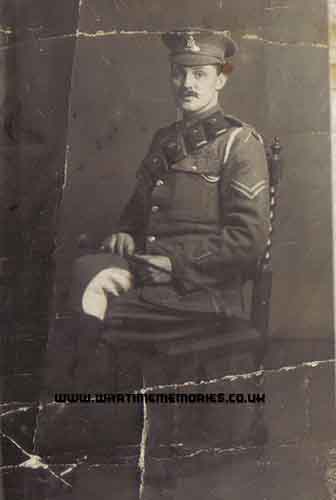Additions will be checked before being published on the website and where possible will be forwarded to the person who submitted the original entries. Your contact details will not be forwarded, but they can send a reply via this messaging system.
please scroll down to send a message
Cpl. George Cooper Evison
British Army 5th Btn. Lincolnshire Regiment
from:Grimsby, Lincolnshire
George Evison enlisted in the Scots Guards on 24th February 1899, just short of his 17th birthday. In the 1901 census he is stationed at Wellington Barracks, Westminster, London. I do not know much about his service in the Guards, but I do know that he served in South Africa during the Boer war as he qualified for the Queens South Africa medal which was confirmed in his later military records. George left the Guards on 23rd February 1906 and returned home. He remained on the reserve list for the Scots Guards for 5 years until February 1911. In March 1911, he signed up, for 5 years, to the Territorial Army, the 5th Battalion of the Lincolnshire regiment, which was based at Grimsby. He attended a fortnights training camp in 1911, 1912 and 1913.
On the 5th August 1914, at the onset of the First World War, the 4th (based at Lincoln) and the 5th Territorial Battalions of the Lincolnshire regiment were mobilised and started preparing for war. The 5th Battalion arrived in France on the 1st March 1915. George was promoted to Corporal on 22nd March 1915 (this was despite being arrested twice for Drunk and Disorderly in November and December 1914, for which he was reprimanded). According to The History of the Lincolnshire Regiment 1914-1918, by Major-General C.R.Simpson, the 4th and 5th Battalions spent some training on trench duties before going to the front line on 9th April.
George was injured in action and hospitalised sometime on or just prior to 2nd July 1915. His injury was described as a scalded foot and he was transported home on the 8th July. According to Major-General Simpson’s book. the battalion at that time was in a position close to Sanctuary Wood and the Germans were attacking with ‘liquid fire’. Whether or not this was the cause of his injury would be pure conjecture.
George returned to France on 20th December 1915, having recovered from his injuries. He remained with the regiment until 1st April 1916, when he returned home for discharge, as his 5-year enlistment was complete. You might think that was enough for a 34-year-old man but no, George decided to re-enlist, joining the Royal Artillery on 7th June 1916. Once again his military record is intact. He joined the 59th Division Training Battery at Ripon where he remained for the remainder of the war.
At the completion of the war, he requested to remain in the army, which was granted. His reward for such loyalty was involvement in the Afghanistan war of 1919. The Afghans, sensing British war weariness, had attacked British garrisons and a short war followed. So, in addition to his Great War medals he was awarded the General Service medal and clasp Afghanistan N.W.F.1919.
He was eventually discharged from the Royal Artillery with the rank of Bombardier on 31st March 1920. However, he did rejoin the Territorial Army for 5 years on 24th June 1920.

